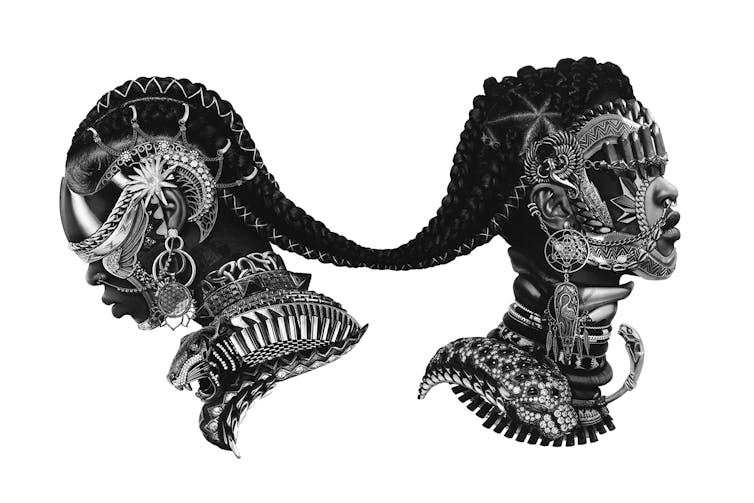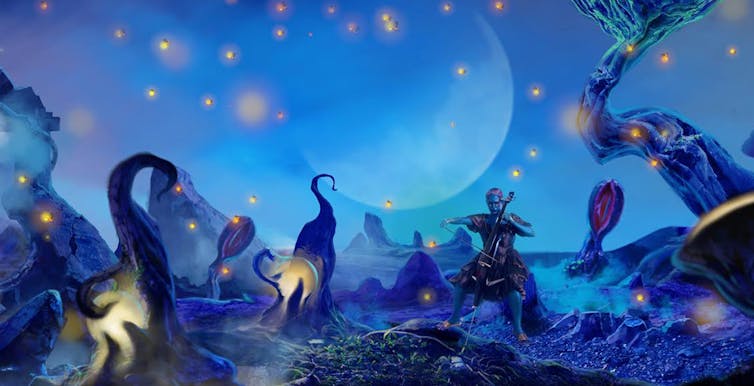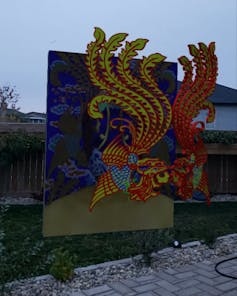Art
Nuit Blanche Toronto goes virtual to change how people see art and public space – The Conversation CA
In streets and kitchens across Canada, viewers and participants can interact with virtual public art to be reminded of diverse histories and communities. This is through Nuit In Your Neighbourhood, a new virtual component of Toronto’s ongoing Nuit Blanche festival, which runs until Oct. 12.
Nehiyaw text-based artist Joi T. Arcand’s artwork celebrates just this when she writes “Never Surrender” in Cree syllabics to honour her own heritage and efforts of solidarity-building between Indigenous communities.
The neon words are delivered to viewers’ spaces in three dimensions through virtual reality and augmented reality technologies. Viewers visit the Nuit in Your Neighbourhood site on a smartphone or tablet, click on avatars of the images, and then can use their device to photograph artists’ works wherever they direct their cameras (some versions of devices may require users to download an app).
Nuit Blanche’s artistic director, Julie Nagam,
brings an approach to curating art that focuses on coalition-building through dialogues and collaboration. I am a research assistant to Nagam working on Nuit Blanche programming and I research Islamic art histories and transcultural curatorial practices.
Both the COVID-19 pandemic and recent debates around public heritage and public monuments shape how Nuit Blanche Toronto is seeking to remap cities. The festival features artists who imagine different futures for BIPOC communities that have been marginalized, and whose work realizes a more liveable present through remapping what an urban space and a community can be.
Re-visioning community & public space
Now, when many people globally are facing another COVID-19 lockdown and the unknowns of stepping into yet another pandemic month, it would be a cliché to state that most of us are exhausted. Many of us are feeling disconnected from what we might have once called community and connection. Both social distancing measures imposed at the outbreak of COVID-19 and vigilant transformations of shared public spaces seen in the removal of colonial monuments have led some people to announce the end of public spaces.
Our societies are reckoning with the fact that public spaces marked by these monuments are not accessible or desirable for everybody.
Read more:
Why activists are vandalizing statues to colonialism
While we’re witnessing the end of a public space as we know it, it is certainly not the end of its possibilities. A recent panel discussion, “Thinking Through Public Space in the Time of COVID,” was part of Nuit Talks, a series of in-depth conversations with Nuit Blanche artists, scholars and curators. During the discussion, Mazyar Mortazavi, board chair for The Bentway, a public art space and park located under Toronto’s Gardiner Expressway, said: “Grief is the first step for recovery.”
There are infinite possibilities for how viewers might engage with Nuit in Your Neighbourhood artworks, from the safety of their own homes or walking through public space.
Nuit in Your Neighbourhood
A common thread that ties together the commissioned works in Nuit in Your Neighbourhood is the artists’ engagement with virtual technologies to critically elevate marginalized histories. Such practices are also seen where Indigenous artists, curators and writers make and imagine space in art exhibitions and in contemporary arts commentary.
Nagam has approached decolonial curating through similar gestures of affirmation and presence. Alongside curator Jaimie Isaac, Nagam curated the groundbreaking exhibition, “INSURGENCE/RESURGENCE” at the Winnipeg Art Gallery in 2017 that created opportunities for a young cohort of artists and BIPOC communities in the city. To this day, it has been the largest exhibition on contemporary Indigenous art in the country.
Space making
With Nuit in Your Neighbourhood images, a person might interact with artists’ images in their domestic or shared public space.
Consider When The Fam Lose Faith, Hold Them Up, by Toronto-based photographic artist Yung Yemi. Viewers could choose to mark the distance gained through Black Lives Matter protests against colonial monuments
by photographing the disgraced statue of Egerton Ryerson in Toronto with this image layered overtop.

(Yung Yemi), Author provided
In the digital medium, the artist’s depicted Afro-futurist figures can travel and establish their own relations, and are both ephemeral and fluid. They bring into reality what Toronto’s own philosopher and communications theorist Marshall McLuhan prophesized: “The medium is the message.”
Another artist whose work invites people to mark space is video and performance artist Rah Eleh’s #Bluegirl. This work is an immersive video that considers self-immolation practices involving young women in the Middle East and Persian-speaking nations in Central Asia.
In #Bluegirl, Eleh visualizes alternatives of survival for these figures that massage out the possibilities of not only the present, but the cosmic past and future.

Author provided
Memories of origins
Maureen Gruben’s Kagisaaluq visualizes cultural traditions to demonstrate their vitality and survival. Kagisaaluq presents a “fox stretcher,” an Inuvialuit tool to stretch and preserve animal skins carved by Gruben’s father to help the family and community thrive in the Arctic. In reproducing this, Kagisaaluq feels as if it reorders space and time to honour traditional forms of survival and knowledge.

Author provided
Artist Chun Hua Catherine Dong has discussed the idea that tradition needs to be expanded. Skin Deep is the artist’s most recent exploration in an ongoing series, where faces are wrapped by different Chinese silk fabrics.
Dong has noted she is not only challenging patterns of sexism in China, but also the “othering” of Chinese Canadian subjects through racism in Canada.
When explored in its augmented reality construction, threads in the form of a fluttering butterfly start to lift from the face. For me, this signals a slow but enduring deconstruction of tradition.
Solidarity across cultures, peoples

Author provided
Nagam’s prioritization of BIPOC artists living in diverse cultural conditions generates solidarities across diverse cultures and peoples. From an esthetic perspective, what is of lasting remembrance is an encounter between the artwork and audience.
In the expanded universe of augmented reality and virtual reality, the artworks engender what curator and artist Amalia Mesa-Bains has referred to as “inter-ethnic intimacy,” borne out of exchange.
Within processes of play and exploration, audience members are invited to understand and feel the different layers and propositions of how space is made. When we are longing for the rush of the Nuit crowd, we are, instead, offered deep connections with other people and other communities, where multiplicity is the work.
Art
Calvin Lucyshyn: Vancouver Island Art Dealer Faces Fraud Charges After Police Seize Millions in Artwork

In a case that has sent shockwaves through the Vancouver Island art community, a local art dealer has been charged with one count of fraud over $5,000. Calvin Lucyshyn, the former operator of the now-closed Winchester Galleries in Oak Bay, faces the charge after police seized hundreds of artworks, valued in the tens of millions of dollars, from various storage sites in the Greater Victoria area.
Alleged Fraud Scheme
Police allege that Lucyshyn had been taking valuable art from members of the public under the guise of appraising or consigning the pieces for sale, only to cut off all communication with the owners. This investigation began in April 2022, when police received a complaint from an individual who had provided four paintings to Lucyshyn, including three works by renowned British Columbia artist Emily Carr, and had not received any updates on their sale.
Further investigation by the Saanich Police Department revealed that this was not an isolated incident. Detectives found other alleged victims who had similar experiences with Winchester Galleries, leading police to execute search warrants at three separate storage locations across Greater Victoria.
Massive Seizure of Artworks
In what has become one of the largest art fraud investigations in recent Canadian history, authorities seized approximately 1,100 pieces of art, including more than 600 pieces from a storage site in Saanich, over 300 in Langford, and more than 100 in Oak Bay. Some of the more valuable pieces, according to police, were estimated to be worth $85,000 each.
Lucyshyn was arrested on April 21, 2022, but was later released from custody. In May 2024, a fraud charge was formally laid against him.
Artwork Returned, but Some Remain Unclaimed
In a statement released on Monday, the Saanich Police Department confirmed that 1,050 of the seized artworks have been returned to their rightful owners. However, several pieces remain unclaimed, and police continue their efforts to track down the owners of these works.
Court Proceedings Ongoing
The criminal charge against Lucyshyn has not yet been tested in court, and he has publicly stated his intention to defend himself against any pending allegations. His next court appearance is scheduled for September 10, 2024.
Impact on the Local Art Community
The news of Lucyshyn’s alleged fraud has deeply affected Vancouver Island’s art community, particularly collectors, galleries, and artists who may have been impacted by the gallery’s operations. With high-value pieces from artists like Emily Carr involved, the case underscores the vulnerabilities that can exist in art transactions.
For many art collectors, the investigation has raised concerns about the potential for fraud in the art world, particularly when it comes to dealing with private galleries and dealers. The seizure of such a vast collection of artworks has also led to questions about the management and oversight of valuable art pieces, as well as the importance of transparency and trust in the industry.
As the case continues to unfold in court, it will likely serve as a cautionary tale for collectors and galleries alike, highlighting the need for due diligence in the sale and appraisal of high-value artworks.
While much of the seized artwork has been returned, the full scale of the alleged fraud is still being unraveled. Lucyshyn’s upcoming court appearances will be closely watched, not only by the legal community but also by the wider art world, as it navigates the fallout from one of Canada’s most significant art fraud cases in recent memory.
Art collectors and individuals who believe they may have been affected by this case are encouraged to contact the Saanich Police Department to inquire about any unclaimed pieces. Additionally, the case serves as a reminder for anyone involved in high-value art transactions to work with reputable dealers and to keep thorough documentation of all transactions.
As with any investment, whether in art or other ventures, it is crucial to be cautious and informed. Art fraud can devastate personal collections and finances, but by taking steps to verify authenticity, provenance, and the reputation of dealers, collectors can help safeguard their valuable pieces.
Art
Ukrainian sells art in Essex while stuck in a warzone – BBC.com
[unable to retrieve full-text content]
Ukrainian sells art in Essex while stuck in a warzone BBC.com

Source link
Art
Somerset House Fire: Courtauld Gallery Reopens, Rest of Landmark Closed
The Courtauld Gallery at Somerset House has reopened its doors to the public after a fire swept through the historic building in central London. While the gallery has resumed operations, the rest of the iconic site remains closed “until further notice.”
On Saturday, approximately 125 firefighters were called to the scene to battle the blaze, which sent smoke billowing across the city. Fortunately, the fire occurred in a part of the building not housing valuable artworks, and no injuries were reported. Authorities are still investigating the cause of the fire.
Despite the disruption, art lovers queued outside the gallery before it reopened at 10:00 BST on Sunday. One visitor expressed his relief, saying, “I was sad to see the fire, but I’m relieved the art is safe.”
The Clark family, visiting London from Washington state, USA, had a unique perspective on the incident. While sightseeing on the London Eye, they watched as firefighters tackled the flames. Paul Clark, accompanied by his wife Jiorgia and their four children, shared their concern for the safety of the artwork inside Somerset House. “It was sad to see,” Mr. Clark told the BBC. As a fan of Vincent Van Gogh, he was particularly relieved to learn that the painter’s famous Self-Portrait with Bandaged Ear had not been affected by the fire.
Blaze in the West Wing
The fire broke out around midday on Saturday in the west wing of Somerset House, a section of the building primarily used for offices and storage. Jonathan Reekie, director of Somerset House Trust, assured the public that “no valuable artefacts or artworks” were located in that part of the building. By Sunday, fire engines were still stationed outside as investigations into the fire’s origin continued.
About Somerset House
Located on the Strand in central London, Somerset House is a prominent arts venue with a rich history dating back to the Georgian era. Built on the site of a former Tudor palace, the complex is known for its iconic courtyard and is home to the Courtauld Gallery. The gallery houses a prestigious collection from the Samuel Courtauld Trust, showcasing masterpieces from the Middle Ages to the 20th century. Among the notable works are pieces by impressionist legends such as Edouard Manet, Claude Monet, Paul Cézanne, and Vincent Van Gogh.
Somerset House regularly hosts cultural exhibitions and public events, including its popular winter ice skating sessions in the courtyard. However, for now, the venue remains partially closed as authorities ensure the safety of the site following the fire.
Art lovers and the Somerset House community can take solace in knowing that the invaluable collection remains unharmed, and the Courtauld Gallery continues to welcome visitors, offering a reprieve amid the disruption.
-

 Politics6 hours ago
Politics6 hours agoNew Brunswick Premier Blaine Higgs expected to call provincial election today
-
Media6 hours ago
Sutherland House Experts Book Publishing Launches To Empower Quiet Experts
-

 News18 hours ago
News18 hours agoAlberta Premier Smith aims to help fund private school construction
-

 News6 hours ago
News6 hours agoQuebec won’t fund graphite mine project tied to Pentagon; locals claim ‘victory’
-

 News18 hours ago
News18 hours agoNova Scotia NDP accuse government of prioritizing landlord profits over renters
-

 Economy18 hours ago
Economy18 hours agoN.B. election: Parties’ answers on treaty rights, taxes, Indigenous participation
-

 News18 hours ago
News18 hours agoHealth Minister Mark Holland appeals to Senate not to amend pharmacare bill
-

 News18 hours ago
News18 hours agoNurse-patient ratios at B.C. hospitals set to expand in fall, says health minister



















